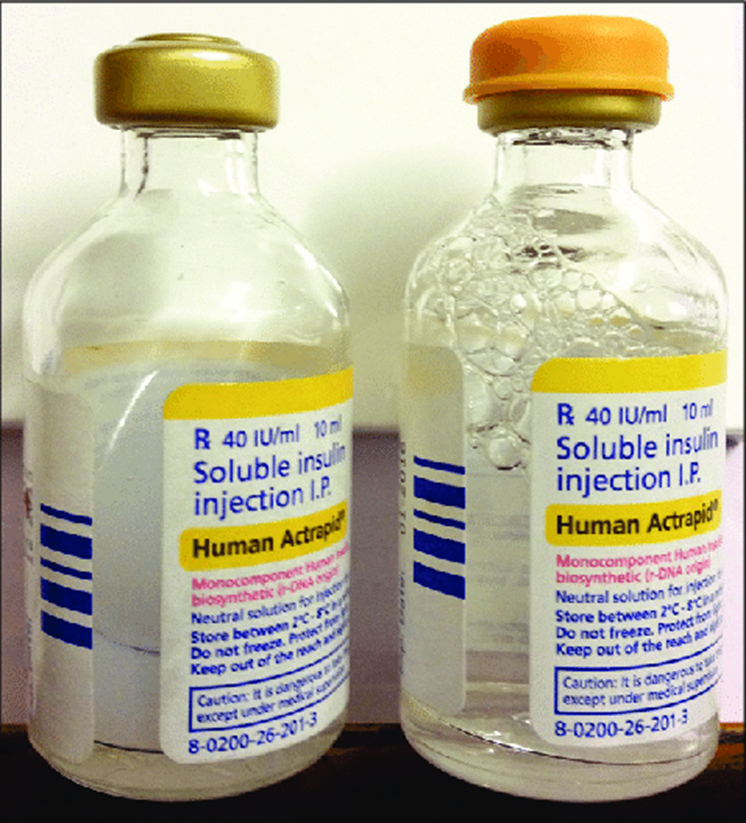What specific administration techniques should the nurse employ when administering NPH insulin?
Never mix with another insulin.
Roll the vial gently to mix the suspension.
Only administer this insulin at bedtime.
When mixing with another insulin, draw the NPH into the syringe first.
The Correct Answer is B
Choice A Rationale:
NPH insulin can be mixed with certain other insulins, such as regular insulin, to achieve different effects and better control blood glucose levels. Therefore, stating that it should never be mixed with another insulin is incorrect.
Choice C rationale:
NPH insulin is an intermediate-acting insulin that can be administered at various times of the day, depending on the individual's needs and blood glucose patterns. It is not restricted to bedtime administration only.
Choice D rationale:
When mixing NPH insulin with another insulin, the order of mixing does not significantly affect its action. The crucial aspect is to ensure proper mixing of the insulins before administration.
Choice B rationale:
NPH insulin is a suspension, meaning the insulin particles are not fully dissolved in the liquid. Therefore, it's essential to roll the vial gently between the palms to evenly distribute the insulin particles throughout the solution. This ensures that the patient receives the correct dose and prevents injection of an uneven mixture, which could lead to unpredictable blood glucose levels.
Key points to remember:
NPH insulin is an intermediate-acting insulin that starts working within 1 to 2 hours, peaks in 4 to 12 hours, and lasts for 12 to 18 hours.
It can be mixed with regular insulin to provide both short-acting and longer-acting insulin coverage. Always follow the specific instructions provided by the insulin manufacturer and healthcare provider. Proper mixing of NPH insulin is crucial for accurate dosing and optimal glucose control.

Nursing Test Bank
Naxlex Comprehensive Predictor Exams
Related Questions
Correct Answer is B
Explanation
Choice A rationale:
Calcitonin (Fortical) is a hormone that lowers blood calcium levels. It is not indicated for the treatment of hypocalcemia caused by parathyroid hormone deficiency. In fact, it could worsen the condition by further reducing calcium levels.
Calcitonin is primarily used to treat hypercalcemia (high calcium levels) and osteoporosis.
It works by inhibiting osteoclast activity, which reduces bone resorption and calcium release into the bloodstream.
Choice B rationale:
Calcium is the essential mineral for treating hypocalcemia. It directly replenishes calcium levels in the blood.
Calcium can be administered orally (PO) or intravenously (IVPB), depending on the severity of the hypocalcemia and the patient's condition.
Oral calcium is often preferred for mild to moderate hypocalcemia, while IV calcium is typically used for severe hypocalcemia or when rapid correction is necessary.
Calcium supplements are available in various forms, including calcium carbonate, calcium citrate, and calcium gluconate. The dosage of calcium will be individualized based on the patient's serum calcium levels and clinical response.
Choice C rationale:
Vitamin B12 is not directly involved in calcium regulation. It is essential for red blood cell production and nerve function. While vitamin B12 deficiency can sometimes be associated with hypocalcemia, it is not a primary treatment for this condition. Choice D rationale:
Vitamin D3 (Calcitriol) is a hormone that aids in calcium absorption from the intestines. It is often used in conjunction with calcium supplements to treat hypocalcemia.
However, vitamin D3 alone is not sufficient to treat hypocalcemia caused by parathyroid hormone deficiency. Parathyroid hormone is essential for activating vitamin D3 in the kidneys, so its deficiency limits the effectiveness of vitamin D3.
Correct Answer is A
Explanation
Choice A rationale:
Regular insulin peaks within 2-4 hours after administration. Therefore, to prevent hypoglycemia due to the insulin administered at 0700, the client should eat breakfast within 1-2 hours of insulin administration. This will ensure that there is glucose available in the bloodstream to match the insulin's action and prevent blood sugar levels from dropping too low.
Breakfast is the most important meal of the day, especially for individuals with diabetes. It helps to regulate blood sugar levels throughout the morning and can even help with weight management and overall health.
Skipping breakfast can lead to fluctuations in blood sugar levels and increase the risk of hypoglycemia, especially after insulin administration.
Choice B rationale:
Supper, typically consumed in the evening, would not be timely enough to prevent hypoglycemia due to the 0700 insulin administration. The insulin's peak action would have already subsided by that time, and the client would be at risk for hyperglycemia (high blood sugar) instead.
Choice C rationale:
Lunch, typically consumed around noon, would also be too late to prevent hypoglycemia from the 0700 insulin administration. The insulin's peak action would have already passed, and the client would be more likely to experience hyperglycemia.
Choice D rationale:
A snack, while it can provide some glucose, is not a substitute for a balanced meal like breakfast. Snacks often contain less protein and fiber, which are essential for slowing down glucose absorption and maintaining blood sugar stability. Relying solely on snacks to prevent hypoglycemia is not a reliable strategy for long-term blood sugar management.
Whether you are a student looking to ace your exams or a practicing nurse seeking to enhance your expertise , our nursing education contents will empower you with the confidence and competence to make a difference in the lives of patients and become a respected leader in the healthcare field.
Visit Naxlex, invest in your future and unlock endless possibilities with our unparalleled nursing education contents today
Report Wrong Answer on the Current Question
Do you disagree with the answer? If yes, what is your expected answer? Explain.
Kindly be descriptive with the issue you are facing.
